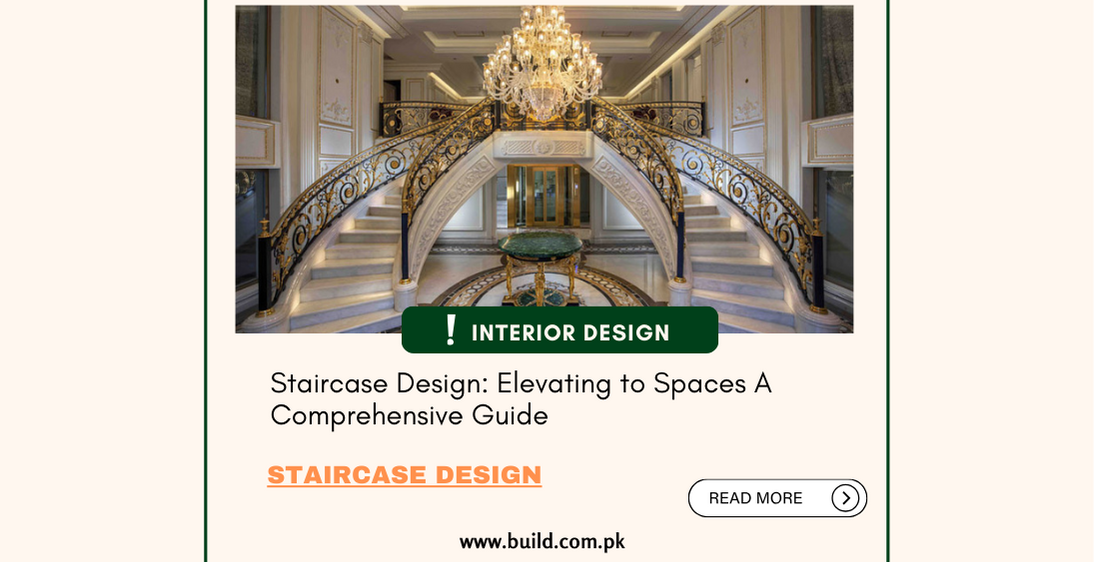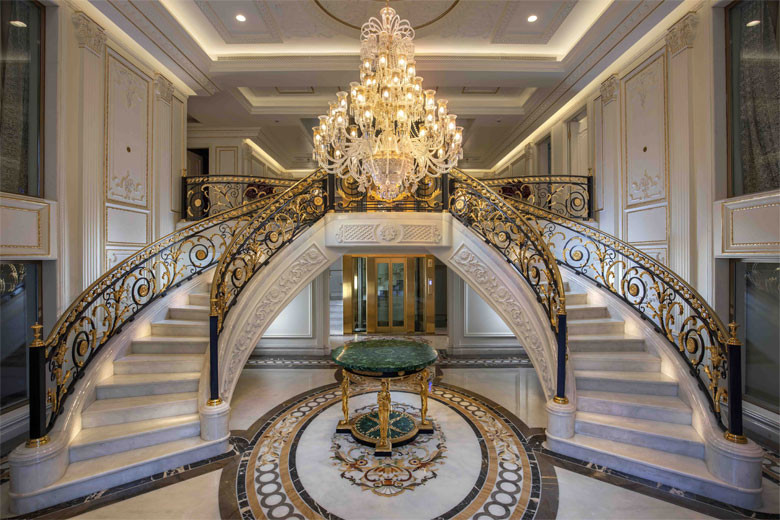Staircase Design: Elevating to Spaces A Comprehensive Guide

Introduction:
Staircases are not mere functional elements; they are
architectural features tha t transcend the mundane, transforming spaces with
elegance and style. This comprehensive guide delves into the intricate world of
staircase design, exploring the myriad possibilities that stairs offer in
shaping the aesthetics and functionality of homes and buildings. From classic
to contemporary, spiral to straight, staircases play a pivotal role in defining
the character of interiors. Let's embark on a journey through the diverse
realms of staircase design, unraveling the nuances that contribute to creating
stairways that are not just paths between levels but statements of design
excellence.
Evolution of Staircase Design:
The evolution of staircase design is a fascinating journey
that mirrors architectural trends and cultural shifts throughout history. From
the grandeur of sweeping staircases in classical European estates to the sleek,
modern lines of contemporary designs, staircases ha ve adapted to the prevailing
sensibilities of their times. Over the years, various styles have emerged, each
reflecting the artistic and structural preferences of its era. Whether it's the
ornate balustrades of Victorian staircases or the minimalistic elegance of mid-century
modern designs, staircases have become a canvas for architectural expression.

Types of Staircases: A Detailed Exploration
Straight Staircases:
Straight staircases, with their timeless simplicity, offer a
classic and functional design that effo rtlessly fits into various architectural
styles. These staircases ascend in a single, uninterrupted line, providing a
straightforward and versatile solution for both residential and commercial
spaces. Their adaptability allows them to seamlessly integrate into different
interior designs, from traditional to modern aesthetics.
Spiral Staircases:
Spiral staircases, a true embodiment of elegance and spatial
efficiency, present a captivating design that spirals around a central axis.
Beyond their functional role, these staircases add a touch of sophistication to
interiors. Their compact footprint makes them ideal f or smaller spaces where
optimizing every inch is crucial. The graceful curvature of a spiral staircase
not only saves space but also becomes a design focal point, adding a dynamic
visual element to the surroundings.
Curved Staircases:
Curved staircases introduce a sense of fluidity and movement
to interiors with their graceful arcs. Often featured in luxury homes and
upscale commercial spaces, these staircases go beyond mere functionality to
become architectural statements. The smooth curves of a curved staircase create
a visually appealing transition between different levels, enhancing the overall
aesthetics of the space.
Floating Staircases:
Floating staircases make a bold architectural statement by
creating a visually striking effect of appearing to "float" in
mid-air. Achieved through concealed supports, these staircases contribute to an
open and airy feel in contemporary and minimalist designs. Th e absence of
visible structural elements underneath the treads adds a sense of lightness and
innovation to the overall design. Floating staircases are often chosen for
their ability to create a focal point in the space while maintaining a clean and
uncluttered aesthetic.
L-Shaped and U-Shaped Staircases:
L-shaped and U-shaped staircases introduce turns or landings,
providing ample opportunities for creative design and functional separation
between different levels. These staircases are versatile and adaptable to
various architectural layouts, allowing for customization based on space
requirements and design preferences. The turns or landings in L-shaped and
U-shaped staircases not only add a design element but also contribute to the
overall safety and ease of use.
Cantilevered Staircases:
Cantilevered staircases defy conventional structural norms by
relying on extended beams or brackets for support, imparting a sense of
lightness and innovation to modern and avant-garde interiors. The design
creates a striking visual effect, with treads seemingly floating without
traditional riser support. Cantilevered staircases often become sculptural
elements within a space, showcasing the integration of architecture and design.
Factors Influencing Staircase Design
Space Constraints:
Description: The available space plays a crucial role in
determining the type of staircase design. Compact spaces may benefit from
spiral or floating staircases, while larger areas allow for the grandeur of
sweeping curves or multiple landings.
Architectural Style:
Description: The overall architectural style of a building
influences the choice of staircase des ign. Classic and traditional styles may
favor ornate balustrades and elaborate detailing, while modern designs lean
towards clean lines and minimalistic features.
Material Selection:
Description: The choice of materials, whether it be wood,
metal, glass, or a combination, greatly influences the aesthetic and structural
integrity of the staircase. Each material brings its own character and
durability to the design.
Safety and Building Codes:
Description: Safety considerations and adherence to building
codes are paramount in staircase design. Handrails, balustrades, and tread
dimensions are carefully regulated to ensure the well-being of users.
User Demographics:
Description: The demographics of the users, including age and
mobility, are essential considerations. Designs may need to accommodate ease of
use for children, elderly individuals, or those with mobility challenges.
Budgetary Constraints:
Description: The available budget significantly influences
the design options. While ornate materials and intricate detailing may be
feasible in high-budget projects, cost-effective designs can still deliver
elegance through thoughtful planning.
Aesthetic Trends Shaping Modern Staircase Design
Explore the latest trends that are reshaping the landscape of
modern staircase design:
Open Riser Designs:
Description: Open riser designs have become a hallmark of
modern staircases, creating a sense of openness and transparency. By allowing
light to filter through the staircase, this trend enhances the overall visual
appeal of interiors. The absence of traditional risers not only contributes to
a more airy atmosphere but also lends a contemporary touch to the space.
Homeowners and designers are increasingly drawn to the clean lines and modern
aesthetic that open riser designs offer, making them a popular choice in
contemporary interior designs.
Metallic Finishes:
Description: Embracing metallic finishes, such as steel or
wrought iron, has emerged as a prominent trend, adding a touch of industrial
chic to staircase designs. These finishes are not limited to their structural
role; they become integral elements of the design, contributing to the overall
aesthetic. The use of metallic finishes is versatile, fitting seamlessly into
both modern and eclectic settings. The juxtaposition of metal elements against
other materials creates a dynamic visual contrast, making it a favored choice
for those seeking a contemporary and edgy staircase design.
Glass Balustrades:
Description: Glass balustrades have gained popularity for
their ability to contribute to an unobstructed view and a feeling of
spaciousness. This contemporary design choice involves transparent or
translucent panels, often paired with sleek handrails for a minimalist effect.
The use of glass balustrades not only enhances safety but also introduces an
element of sophistication. This trend is particularly well-suited for spaces
where maximizing natural light and creating a visually open environment are
priorities.
Contrasting Materials:
Description: The trend of mixing contrasting materials has
gained traction in modern staircase design. This involves combining different
materials, such as a wooden staircase paired with metal balustrades. The
intentional use of diverse textures and materials creates a dynamic and
visually interesting design. Homeowners and designers are drawn to the
versatility of this trend, allowing for the creation of customized staircases
that make a bold design statement while harmonizing with the overall aesthetic
of the space.
Hidden Storage:
Description: Integrating storage within the staircase has
become a practical and space-saving trend. Cleverly concealed drawers or
compartments within the steps provide a seamless and efficient solution for
decluttering. This trend emphasizes the fusion of functionality and design,
allowing staircases to serve a dual purpose in modern living spaces. The
incorporation of hidden storage aligns with the contemporary lifestyle, where
optimizing space without compromising on aesthetics is a key consideration.
Conclusion:
Staircase design, beyond its functional role, is an art form that shapes the very essence of a space. From the grandeur of sweeping curves to the efficiency of spirals, each design choice tells a unique story. The evolution of staircase design reflects the ever-changing landscape of architecture, blending functionality with aesthetics. As we navigate through the diverse types, influencing factors, and contemporary trends in staircase design, it becomes evident that staircases are not mere connectors of levels but integral elements that elevate the overall design of a space. Whether classic or cutting-edg e, the staircase stands as a testament to the seamless fusion of form and function in architectural design.









